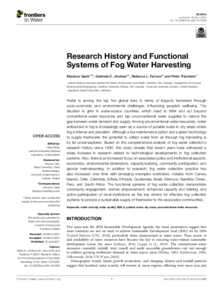Document
Research history and functional systems of fog water harvesting.
Identifier
DOI: 10.3389/frwa.2021.675269
Source
Frontiers in Water. v. 3, 675269
Contributors
Country
Switzerland
Publisher
Frontiers Media S. A.
Gregorian
2021-04-30
Language
English
Subject
English abstract
Water is among the top five global risks in terms of impacts translated through socio-economic and environmental challenges, influencing people's wellbeing. The situation is grim in water-scarce countries, which need to think and act beyond conventional water resources and tap unconventional water supplies to narrow the gap between water demand and supply. Among unconventional water resources, water embedded in fog is increasingly seen as a source of potable water in dry areas where fog is intense and prevalent. Although a low maintenance option and a green technology to supply freshwater, the potential to collect water from air through fog harvesting is by far under-explored. Based on the comprehensive analysis of fog water collection's research history since 1980, this study reveals that recent years have witnessed a sharp increase in research related to technological developments in fog collection systems. Also, there is an increased focus on associated policy and institutional aspects, economics, environmental dimensions, capacity building, community participation, and gender mainstreaming. In addition to research, fog water collection practice has also increased over time with emerging examples worldwide, notably from Canary Islands, Chile, Colombia, Eritrea, Ethiopia, Guatemala, Israel, Morocco, Namibia, Oman, Peru, and South Africa. The functional systems of fog water collection demonstrate community engagement, women empowerment, enhanced capacity and training, and active participation of local institutions as the key drivers for effective fog collection systems to provide a sustainable supply of freshwater to the associated communities.
ISSN
2624-9375
Category
Journal articles

